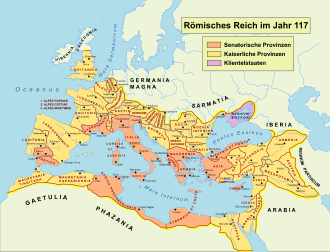Cursus publicus


The term cursus publicus ( Latin roughly: “state transport”) describes a system for the transport of messages , goods and people during the Roman Empire , which was introduced under Augustus .
history
The original purpose of the cursus publicus was most likely to make communication with all provinces of the Roman Empire as quick and easy as possible. To this end, young men were initially posted along important streets to receive messages, pass them on and pass them on to the next runner. Later, a single mounted messenger carried a message from the sender to the recipient. He had at designated exchange stations the opportunity exhausted horses to exchange them rested.
This method was used around 500 BC. Also used in ancient Iran and by the Persians to transport messages quickly over the royal roads, which had already reached a length of 2600 km and led from Susa in all directions of the Persian Empire .
Functionality and infrastructure
The state issued entitlement certificates to people who could use them to use various facilities and services on their way. The necessary infrastructure consisted primarily of an ever-expanding network of roads and shipping lines that connected important cities, regions and ports.
A supporting pillar of the cursus publicus were the services to be provided by the population: For individual cities and municipalities, capacities for riding or draft animals and vehicles were set, which had to be forcibly rented to travelers of the cursus publicus . The governor of the respective province paid the landlords compensation for this. The users of the cursus publicus and their animals had to be provided with rest and overnight accommodation free of charge, while they had to pay for food themselves at market prices.
Beneficiaries
Which group of people services cursus publicus could take, was the Emperor determined. These were mainly high-ranking state officials or military authorities.
In the early days, travelers were only granted the right to use the cursus publicus because of their appearance, perhaps also by wearing a uniform . Because of rampant abuse, this practice was replaced by the requirement of identification with imperial authorization certificates. Each user was allocated precisely defined quotas for the animals and / or vehicles to be claimed. Furthermore, private entrepreneurs could be given the privileges to transport goods that were considered important by the state.
Goods carried
Mainly building materials (e.g. marble) were transported, but also tax money and other needs of the court in Rome (such as horses or wild animals). Messages and messengers continued to be carried, and in addition to them, officials on business trips and their luggage could also use the services of the cursus publicus .
Later development
In the 4th century , the cursus publicus was differentiated into the cursus velox (Latin for example: "fast transport"), which from now on was responsible for urgent transport of messages and people, and the cursus clavularis , which specialized in slower, especially heavy- load transports . It should be noted that this development progressed at different speeds or at different levels in the provinces, depending on local needs.
Institutions of the cursus publicus existed until the end of the Roman Empire, and more or less large parts of the system were often adopted by the subsequent states. The service was largely discontinued in the Eastern Roman Empire by Emperor Justinian I (527-565) ( Prokop, Secret History 30.1-11).
See also
literature
- Roy W. Davies: Service in the Roman Army. Edinburgh University Press, Edinburgh 1989, ISBN 0-85224-495-9 .
- Werner Eck : The administration of the Roman Empire in the high imperial era. Selected and extended articles. Volume 2 (= work on Roman epigraphy and antiquity. Volume 3). Reinhardt, Basel et al. 1998, ISBN 3-7245-0962-6 .
- Erik J. Holmberg: On the history of the Cursus Publicus. Lundequist, Lund 1933 (also: dissertation, Uppsala University 1933).
- Anne Kolb : Transport and message transfer in the Roman Empire (= Klio supplements. New series, volume 2). Akademie Verlag, Berlin 2001, ISBN 3-05-003584-6 .
- Anne Kolb : Post. In: The New Pauly (DNP). Volume 1, Metzler, Stuttgart 1996, ISBN 3-476-01471-1 , Sp. 218-220.
- Anne Kolb : Cursus Publicus. In: The New Pauly (DNP). Volume 3, Metzler, Stuttgart 1997, ISBN 3-476-01473-8 , Col. 245 f.
- Lukas Lemcke: Imperial Transportation and Communication from the Third to the Late Fourth Century. The Golden Age of the cursus publicus (= Collection Latomus. Volume 353). Éditions Latomus, Brussels 2016, ISBN 978-90-429-3356-9 .
- Otto Seeck : Cursus publicus . In: Paulys Realencyclopadie der classischen Antiquity Science (RE). Volume IV, 2, Stuttgart 1901, Col. 1846-1863.
- Pascal Stoffel: About the state post, the ox teams and the commandeered ox teams. A representation of the Roman postal system based on the laws of the Codex Theodosianus and the Codex Iustinianus (= European university publications. Series 3: History and its auxiliary sciences. Volume 595). Lang, Bern et al. 1994, ISBN 3-906751-84-8 (at the same time: dissertation, University of Zurich 1993).


